Family : Acanthuridae

Text © Giuseppe Mazza

English translation by Mario Beltramini
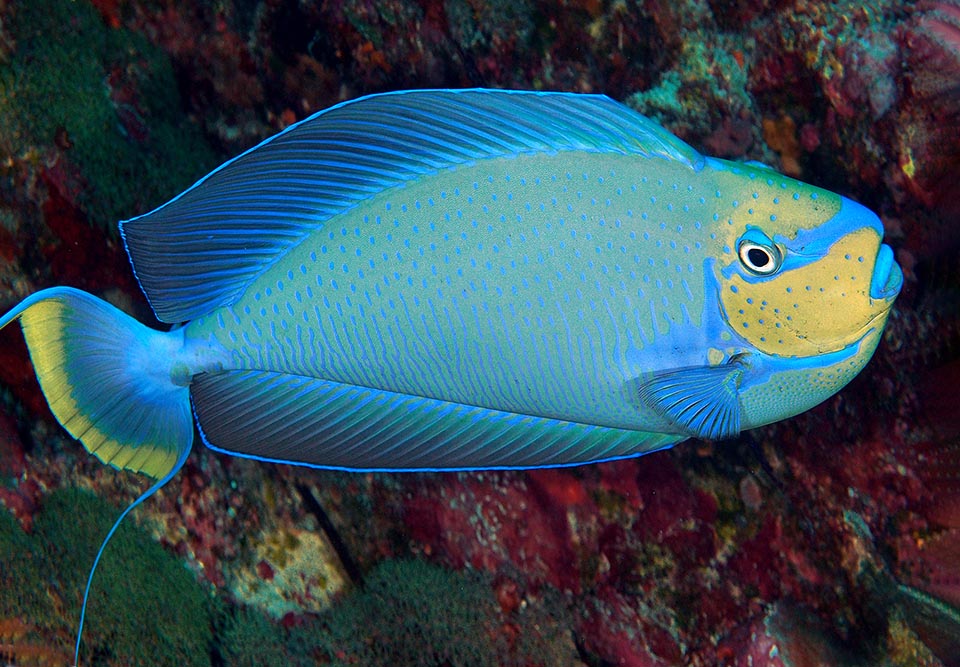
The Vlaming’s unicornfish (Naso vlamingii) has a very wide distribution in tropical Indo-Pacific waters. It can reach 60 cm of length, with sometimes a dazzling livery as in this spectacular image. The refined blue drawing can subside depending on the environment where it swims, the fish mood or its mimetic needs © Florent Charpin
The Naso vlamingii (Valenciennes, 1835), vulgarly known as Vlaming’s unicornfish belongs to the class of Actinopterygii, the ray-finned fishes, to the order of Perciformes, and to the family of Acanthuridae, that counts 6 genera and 84 species united in 3 subfamilies.
Among them, the biggest one is that of Acanthurinae, that includes the genus Acanthurus, the so-called surgeonfishes due to the sharp blade on the caudal peduncle, and the genera Ctenochaetus, Paracanthurus and Zebrasoma, frequent guests of the aquaria like Zebrasoma flavescens or Paracanthurus hepatus. The smallest subfamily is the one of Prionurinae, with only 7 species belonging to the genus Prionurus, whilst the Nasinae, also here with only one genus, the Naso, count a twenty of species known as the Unicornfishes because of the unusual bony protuberance on the snout, well evident in Naso unicornis.
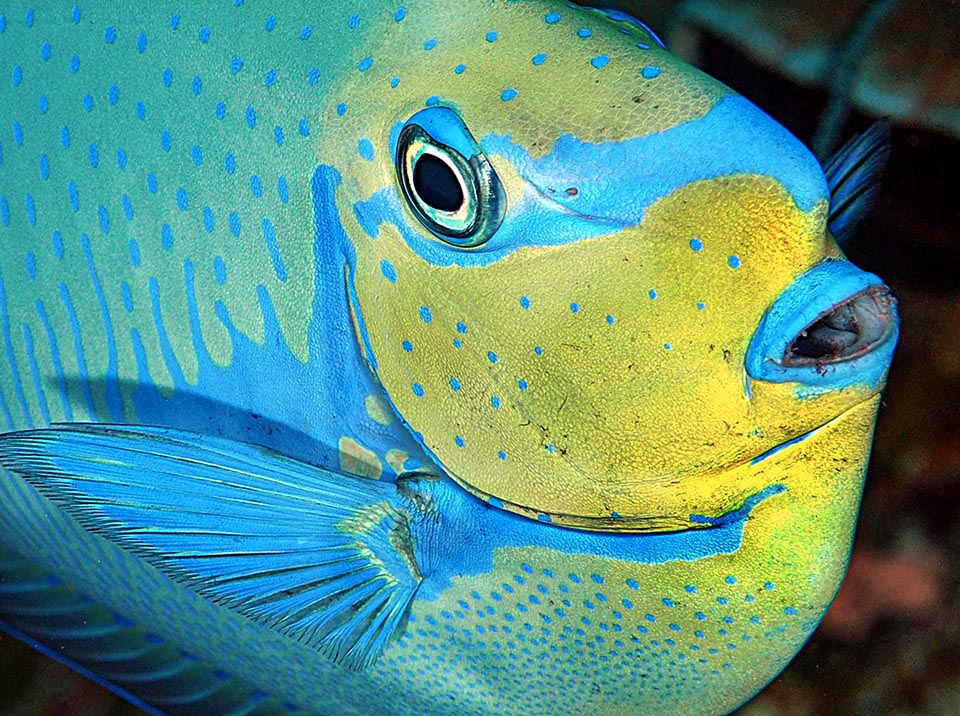
The yellow mustard colour of the head usually doesn’t change, where stand out in blue the lips and the typical front mask going to the eyes © Florent Charpin
This bump, however, may be absent, like in Naso lituratus, or just hinted, more like a nose than to a horn, as in Naso vlamingii.
Needless to say that the genus Naso comes from the Latin word “nasus” = nose, whilst the specific epithet vlamingii, in Latin, literally of Vlaming, honours the memory of Willem Hesselsz de Vlamingh (1640-1698), Dutch sea master, who explored the central-western coast of Australia disembarking in the port of present Perth and christening Swan, that is swan, the river navigated by unusual black swans. He was the first European to see them and still now the river of the capital of Western Australia has this name.
Zoogeography
Like other Nasinae, the Vlaming’s unicornfish has a very vast distribution in the tropical Indo-Pacific waters.
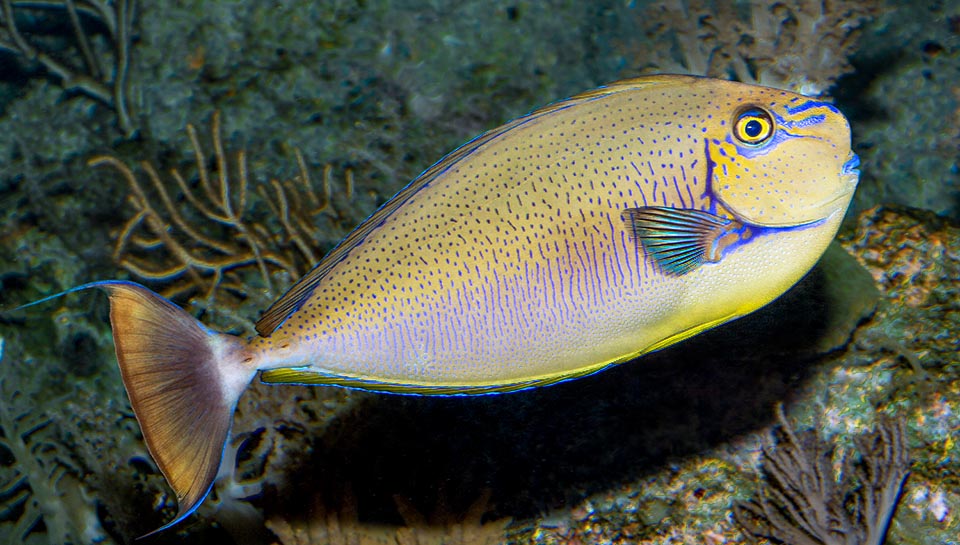
More than a real horn, these fishes have a bony bulge similar to a nose. The bluish dotting of the body joins in hatches towards the belly © Giuseppe Mazza
Indicatively, starting from Somalia, we find it along the African coast up to South Africa, in Madagascar and in the Comoro Islands, Réunion, Mauritius, Seychelles and Maldives. It is present also along the coasts of India, Malaysia, Indonesia and then, northwards, in Vietnam, Philippines, Taiwan and Japan. In Oceania, after Australia and Papua New Guinea, reaches New Caledonia. Proceeding eastwards, it has colonized the Fiji Islands, Tonga, Samoa, Cook Islands, Hawaii, French Polynesia, and it has even reached, now in South America, the Galapagos.
Ecology-Habitat
It is a diurnal fish, associated with the madreporic formations, who goes swimming in shallow waters and never goes down under 50 m. It is often found in the lagoons, but also in the outer side of the reefs, in the sites where concentrate the zooplankton carried by the currents.
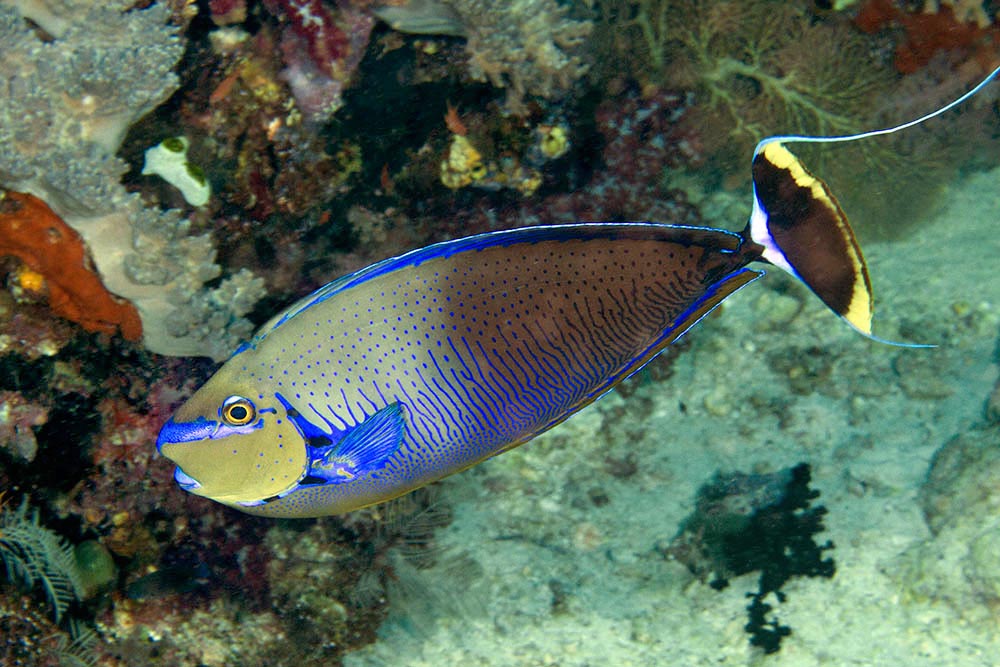
Male with changing background colour. The caudal fin is slightly rounded with yellow band and blue filamentous lobes © Paddy Ryan
Morphophysiology
Naso vlamingii can reach the length of 60 cm. The profile of the body is oval, with the characteristic bony protuberance, over the mouth, decorated with an elegant blue small mask that reaches the eyes.
The caudal peduncle is narrow, and like in the other Unicornfishes, it has two hooked blades per side. They are of modest size, surely not comparable to the showy ones of Naso elegans or of Naso unicornis.
The mouth is small, with blue lips and conical teeth with blunt or serrated tips for better cutting the algae belonging to its diet.
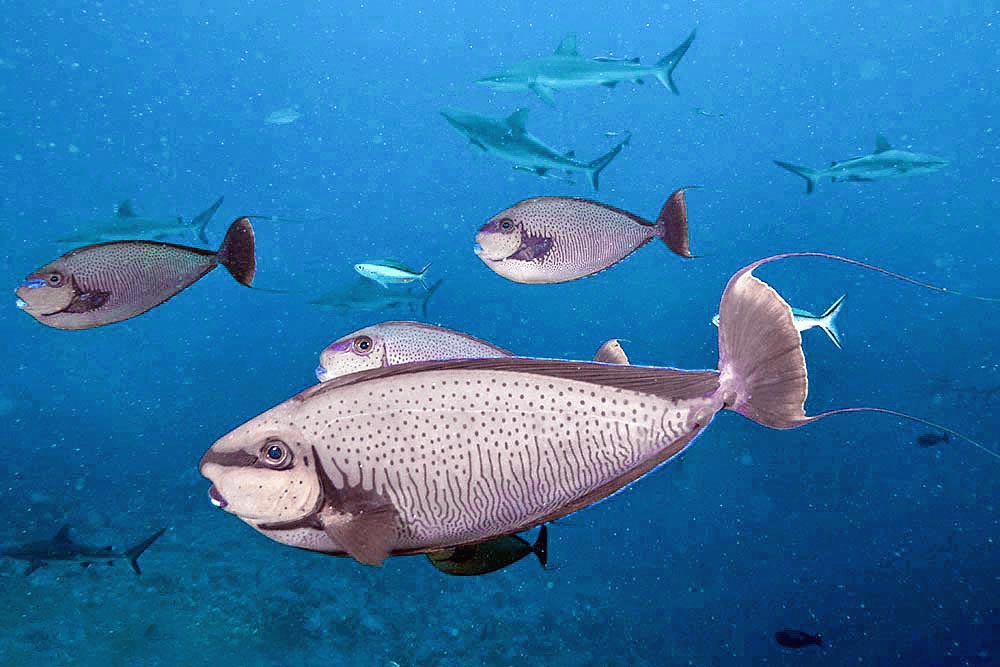
The Vlaming’s unicornfish lives alone, in couple or in small schools. In the foreground majestic male are visible the two cutting hooked blades of the caudal peduncle © Paddy Ryan
There is only one long and showy dorsal fin, unusually high for the genus Naso, that counts 6 spiny rays and 24-27 soft. Of decidedly variable colour brown to blue, has always, however, a turquoise small border. The anal fin, of analogous look, is symmetrical, with 3 spiny rays and 23-24 unarmed.
The pectoral fines are usually blue with 17-19 soft rays, whilst the pelvic, yellow and pointed, has one spiny ray and 9 unarmed ones.
The caudal fin is bluish, roughly trapezoid, with yellow margin often slightly rounded and blue filamentous lobes, that in the males grow out of all proportion with the age, displaying, together with the most developed caudal blades, as minor sexual dimorphism.
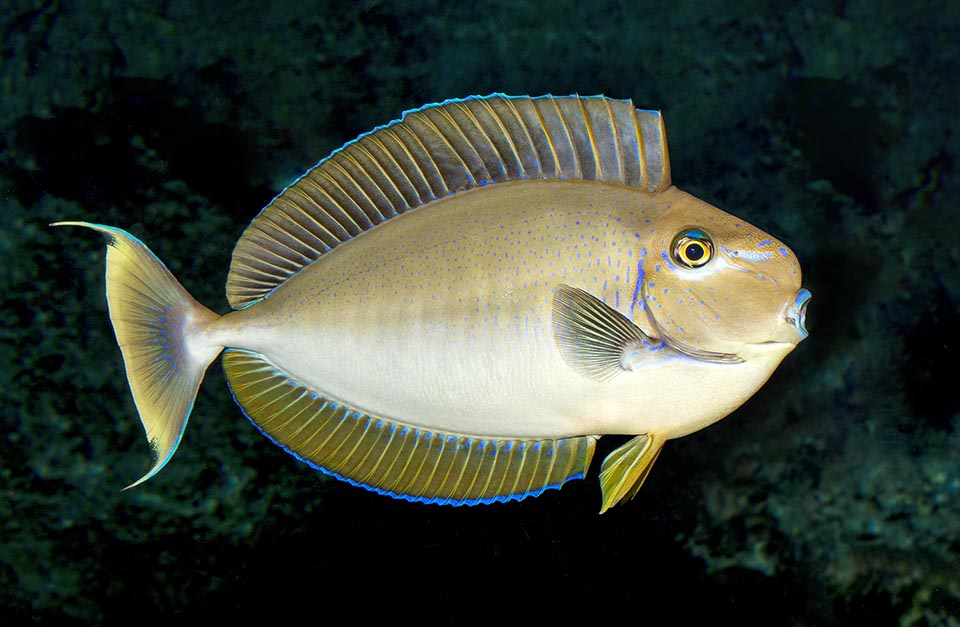
The dorsal and the anal fins are much higher than the congeners. The mouth has serrated teeth to cut easily the algae completing its feeding based on the zooplankton © Giuseppe Mazza
It also seems that the males have chromatophores more efficient than those of the females to quickly adapt to the environment and especially, to manifest their state of mind with dazzling liveries.
Head apart, of mustard colour with blue dots, the background colour of the body can in fact vary from yellowish reddish to pale blue, with a blue dotting that merges forming hatchings towards the belly. In this way, originates a characteristic drawing that however may subside in an instant, to almost disappear, masked in the night by a mimetic livery rich in light and dark hues.
The young have a roundish profile, of brown mustard colour with scattered dark spots that, while growing, gradually turn blue.
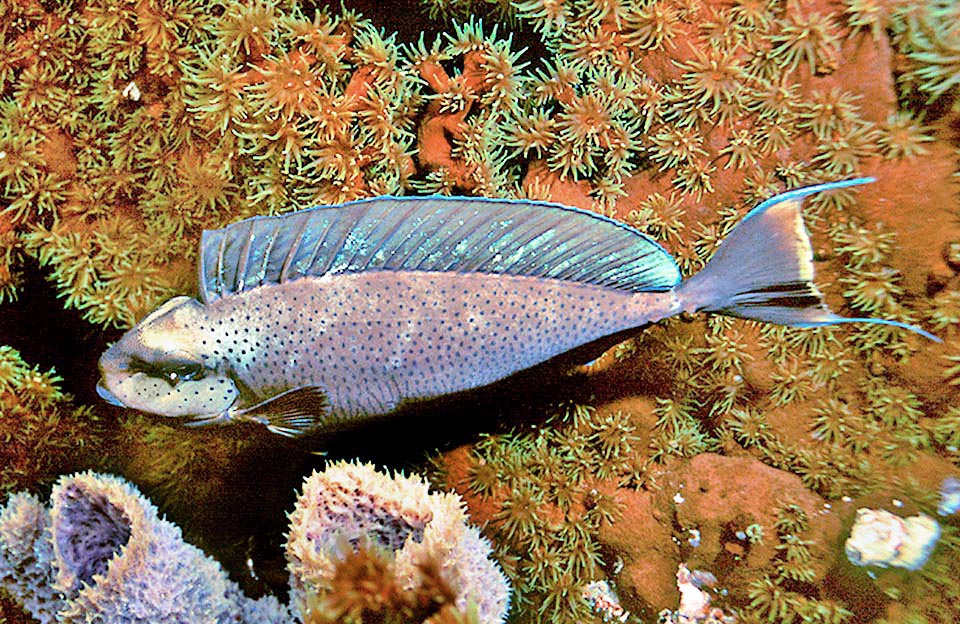
Rare night photo showing the “mimetic pajama”of this species, rich in light and dark to sleep calmly © Keoki Stender
Ethology-Reproductive Biology
The Vlaming’s unicornfish lives isolated, in couples or in small groups, nourishing mainly of zooplankton as well as of algae, of the genera Cladophora, Dictyota, Padina, Turbinaria Jania, and Laurencia, and of the organic debris depositing on the seabeds.
It is therefore an omnivore, less attracted than the congeners, by a vegetarian diet.
The eggs, fecundated while swimming, are entrusted to the currents. The larval phase lasts a long time, with the young consequently growing in often far locations, colonizing new reefs as is shown by the huge diffusion of the species.
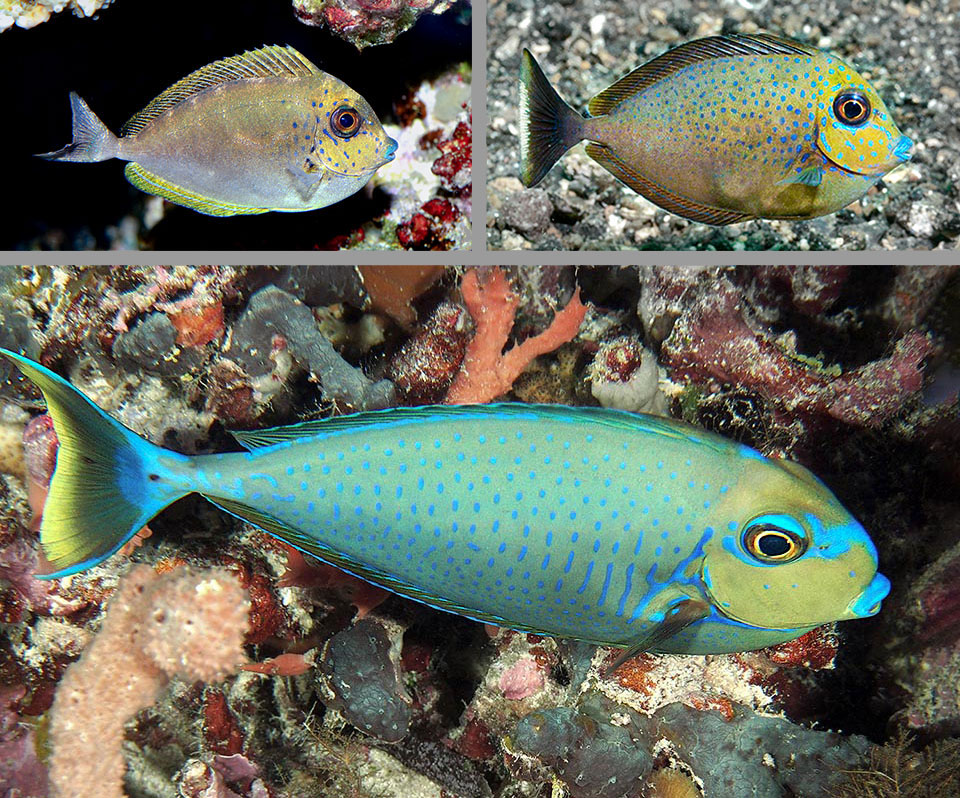
Jouveniles, with roundish profile, are brown-mustard with dark small spots. Then, when the body elongates, these become blue and the typical design appears © Jose Luis Bello Arranz © Joe Shields, Reef Life Survey © Florent Charpin
Naso vlamingii is often a guest of the large public aquaria, the only ones that can ensure it, seen its feeding and size, a decent life.
The resilience of the species is low, as 4.5-14 years are required for renovating the populations decimated by events, but the fishing vulnerability index marks only 38 on a scale of 100.
The populations are decreasing, but considering the abundance of food and its vast range Naso vlamingii has been listed since 2012 as “LC, Leaast Concern” in the IUCN Red List of endangered species.
Synonyms
Naseus vlamingii Valenciennes, 1835.
→ For general information about FISH please click here.
→ For general information about BONY FISH please click here
→ For general information about CARTILAGINOUS FISH please click here.
→ To appreciate the BIODIVERSITY of BONY FISH please click here.
→ To appreciate the BIODIVERSITY of CARTILAGINOUS FISH please click here.
